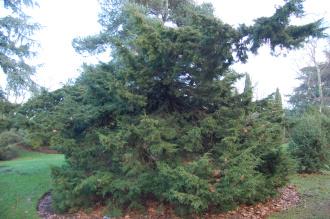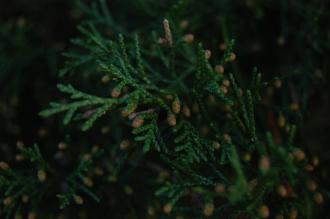
Juniperus virginiana ‘Glauca’ (30/12/14, Kew Gardens, London)
Position: Full sun
Flowering period: Late winter
Soil: Moist, well drained
Eventual Height: 8m
Eventual Spread: 3m
Hardiness: 3b, 4a, 4b, 5a, 5b, 6a, 6b, 7a, 7b, 8a, 8b, 9a
Family: Cupressaceae
Juniperus virginiana ‘Glauca’ is a slow growing, long lived evergreen small tree or large shrub with a columnar habit. Its mid blue/ gray leaves appear in two forms, juvenile and adult. Its juvenile leaves are sharp, needle like, spreading and up to 10cm long. Its adult leaves are scale like and up to 4mm long. Its trunk is short. Its red/ brown bark is fibrous and peels off in narrow strips. Its (usually) dioecious flowers are pollen cones are light brown, up to 3mm long, wind pollinated and are not self fertile. Its dark purple fruit are berry like seed cones and are up to 7mm across.

Juniperus virginiana ‘Glauca’ Leaf (30/12/14, Kew Gardens, London)
Juniperus virginiana ‘Glauca’, commonly known as Silver Eastern Red Cedar, is native to eastern North America. In it native habitat it grows in prairies, old pastures and limestone hills. Some people are allergic to the pollen of this tree.
The etymological root of the binomial name Juniperus is derived from the old Latin name for the Juniper tree. Virginiana is derived from the Latin meaning ‘from Virginia, USA’.
The landscape architect may find Juniperus virginiana ‘Glauca’ useful as an attractive upright evergreen tree. Once established this tree is drought tolerant.

Juniperus virginiana ‘Glauca’ Pollen Cones (30/12/14, Kew Gardens, London)
Ecologically, Juniperus virginiana ‘Glauca’ seed cones are attractive food for birds and mammals. Its structure provides shelter for birds.
Juniperus virginiana ‘Glauca’ prefers moist, fertile, well-drained soils. It tolerates most pH of soil.
Juniperus virginiana ‘Glauca’ requires little maintenance.

